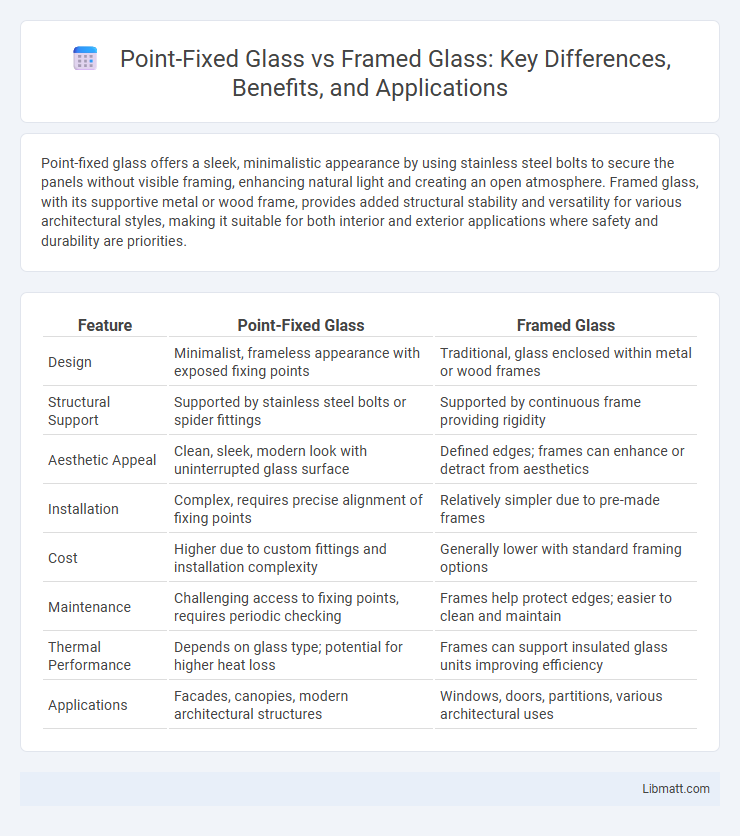Point-fixed glass offers a sleek, minimalistic appearance by using stainless steel bolts to secure the panels without visible framing, enhancing natural light and creating an open atmosphere. Framed glass, with its supportive metal or wood frame, provides added structural stability and versatility for various architectural styles, making it suitable for both interior and exterior applications where safety and durability are priorities.
Table of Comparison
| Feature | Point-Fixed Glass | Framed Glass |
|---|---|---|
| Design | Minimalist, frameless appearance with exposed fixing points | Traditional, glass enclosed within metal or wood frames |
| Structural Support | Supported by stainless steel bolts or spider fittings | Supported by continuous frame providing rigidity |
| Aesthetic Appeal | Clean, sleek, modern look with uninterrupted glass surface | Defined edges; frames can enhance or detract from aesthetics |
| Installation | Complex, requires precise alignment of fixing points | Relatively simpler due to pre-made frames |
| Cost | Higher due to custom fittings and installation complexity | Generally lower with standard framing options |
| Maintenance | Challenging access to fixing points, requires periodic checking | Frames help protect edges; easier to clean and maintain |
| Thermal Performance | Depends on glass type; potential for higher heat loss | Frames can support insulated glass units improving efficiency |
| Applications | Facades, canopies, modern architectural structures | Windows, doors, partitions, various architectural uses |
Introduction to Point-Fixed Glass and Framed Glass
Point-fixed glass features glass panels secured by discrete points using stainless steel bolts or spider fittings, enabling an unobstructed, sleek facade with minimal visible support. Framed glass employs a full framework of metal or aluminum profiles surrounding the glass panels, providing structural integrity and a traditional appearance with clearly defined edges. Both systems serve different architectural needs, with point-fixed glass favoring aesthetic transparency and framed glass emphasizing robustness and safety.
Defining Point-Fixed Glass Systems
Point-fixed glass systems use discreet stainless steel fittings to secure glass panels at specific points, allowing for almost uninterrupted views and a sleek, modern aesthetic. These systems provide structural support without the bulk of traditional framing, making them ideal for curtain walls, skylights, and facades where transparency and minimalism are desired. Your choice between point-fixed and framed glass depends on the design goals, with point-fixed offering enhanced visual clarity and framed glass providing more conventional support and versatility.
Overview of Framed Glass Installations
Framed glass installations feature glass panels securely encased within metal or wooden frames, providing structural support and enhanced durability for architectural applications. These frames accommodate various glass types, including tempered, laminated, or insulating glass, and enable easier replacement or maintenance compared to point-fixed glass systems. Framed glass is widely used in curtain walls, windows, and doors, delivering both aesthetic appeal and reliable protection against environmental elements.
Structural Performance and Load Distribution
Point-fixed glass systems provide superior structural performance by transferring loads directly to discrete supports, minimizing stress concentration and allowing for greater glass transparency and design flexibility. Framed glass relies on a perimeter frame to distribute loads, which can introduce additional stress points and limit the size and shape of the glass panels. Your choice between these systems should consider the desired aesthetics and structural demands of the project to ensure optimal load distribution and safety.
Aesthetic Differences and Design Flexibility
Point-fixed glass systems offer a sleek, minimalist aesthetic by eliminating bulky frames, maximizing transparency and natural light. Framed glass provides greater design flexibility with customizable frame materials and profiles to match architectural styles and support various window shapes. The choice between point-fixed and framed glass significantly influences building appearance and facade integration.
Installation Process and Complexity
Point-fixed glass installation involves securing glass panels using stainless steel bolts or spider fittings, allowing for a sleek, frameless appearance but requiring precise alignment and specialized hardware. Framed glass installation uses aluminum or steel frames to hold glass panes, offering easier installation with standardized components but resulting in a bulkier look. The complexity of point-fixed systems is higher due to custom engineering and exact tolerances, while framed systems provide faster assembly suitable for large-scale projects.
Maintenance Requirements and Longevity
Point-fixed glass systems feature fewer components exposed to the elements, reducing maintenance needs compared to framed glass, which often requires regular inspections and sealant replacements to prevent leaks. The minimalist design of point-fixed glass enhances durability by minimizing frame-related deterioration, extending your glass structure's lifespan. Choosing point-fixed glass can lead to lower long-term maintenance costs and improved structural longevity.
Energy Efficiency and Thermal Performance
Point-fixed glass systems offer superior energy efficiency with minimal framing that reduces thermal bridging, allowing for better insulation and natural light penetration. Framed glass tends to have more metal components, which can conduct heat and reduce overall thermal performance unless thermal breaks or specialized glazing are used. When optimizing your building's energy use, point-fixed glass provides enhanced thermal resistance, helping maintain consistent indoor temperatures and lower energy costs.
Cost Comparison: Point-Fixed vs Framed Glass
Point-fixed glass generally incurs higher installation costs due to specialized hardware and precise engineering requirements, whereas framed glass systems tend to have lower upfront expenses with more straightforward assembly. Maintenance costs for point-fixed glass can be higher over time because of potential sealant failures and hardware wear, while framed glass offers easier replacement and repair options at reduced costs. Your choice between the two should consider both initial investment and long-term maintenance budgets for optimal cost efficiency.
Key Applications and Ideal Use Cases
Point-fixed glass excels in modern architectural designs requiring minimal visual obstruction, often used in facades, atriums, and skylights to maximize natural light and create sleek, transparent surfaces. Framed glass is ideal for traditional window installations, partition walls, and doors where structural support and weather sealing are critical, offering durability and ease of maintenance. Your choice depends on whether aesthetic minimalism or reinforced stability best suits the specific functional demands of your building project.
point-fixed glass vs framed glass Infographic

 libmatt.com
libmatt.com